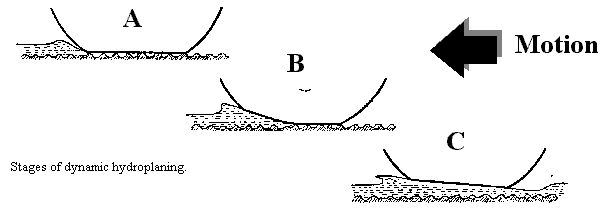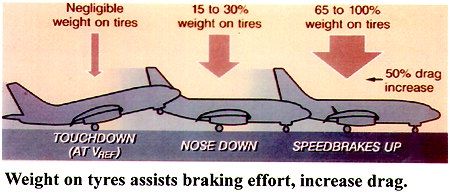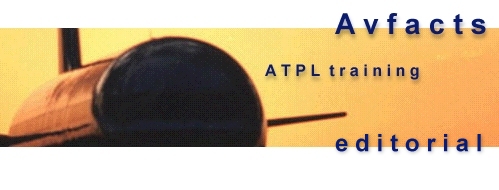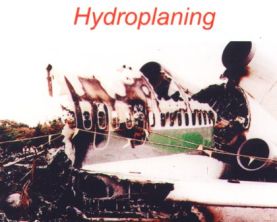| General
History indicates that:
- Almost 60% of Rejected Takeoff (RTO) decisions by airline
crews are incorrect, often leading to the aircraft overrunning
the end of the runway.
|
- About 50% of all airliner accidents occur
during the approach/landing phase of the flight.
|
- About 28% of all airliner accidents occurring
on the runway are the result of “overruns”.
|
A factor in many, but not all overruns, is that the runway was
contaminated by water, ice, snow, or slush (wet snow). It is important for
you, as the future operator of airline type aircraft, to know that
anything other than a perfectly dry, sealed runway, may significantly
reduce braking force applied through the tyres.
Hydroplaning
Definition: This describes a situation when a tyre is
lifted clear of the runway due to fluid pressure beneath the tyre. Such a
condition happens mostly when the runway is wet, and occurs when fluid
(water, slush) is not displaced at a rate fast enough from the tyre/ground
contact area (footprint). A melted area of tyre can achieve the same
effect, whether on a wet or dry runway (called “Reverted Rubber
Hydroplaning”).
The result of the tyre not being in touch with the runway
is a total loss of braking ability. When hydroplaning occurs, the tyre
rides or skids on a wedge or film of fluid over all or part of it’s
footprint area. This wedge is the residual surface fluid that has not been
removed by the tyre from the footprint area. As speed increases the wedge
moves further back on the footprint area, until at “Full Hydroplaning
Speed” it has lifted the tyre clear of the runway surface. At lesser
speeds there may be “Partial Dynamic Hydroplaning”.
Water, and contaminated water has extremely low friction
capability, and so a tyre riding on a film of water has little or no
braking friction at all.
 |
The build up of fluid pressure beneath
a tyre depends on:
- tyre pressure
- fluid layer thickness
- fluid density and viscosity
- runway texture
- tyre tread pattern and depth
- groundspeed
|

Full dynamic hydroplaning.
Tyre “planes” on standing water.
|
 |
Dynamic hydroplaning
Really, this can be split into two sub-types, namely “Partial
Dynamic Hydroplaning”, and “Full Dynamic Hydroplaning”.
Partial dynamic hydroplaning occurs regularly when operating
on contaminated runways, and the antiskid system does a very good
job of limiting it’s effect on braking.
This is where PART of the tyre is lifted off the
runway due to the effect of the fluid
wedge. It can occur to a grooved treaded tyre at water depths of
about 2mm or more. |
|

The above diagram shows three wheels
at various groundspeeds on the same flooded runway.
At “A” the aircraft is moving forward slowly, and the
entire footprint is in contact with the pavement. The tyre is
managing to “pump” enough water off the runway as the wall of
water built up at the front is small.
At “B” the aircraft is moving at such a speed that the
wall of water ahead of the tyre cannot be entirely pumped off the
runway surface, and a wedge of water is lifting part of the tyre
clear of the runway. This is partial dynamic
hydroplaning.
At “C” the aircraft has accelerated to it’s full
dynamic hydroplaning speed, as witnessed by the entire tyre
being lifted off the runway. This means, in the case
of the B747-400, the entire 397, 000 kg weight of the aircraft at
takeoff is being supported on a film of water only a few millimetres
thick.
Finding the minimum speed for hydroplaning
The major factor involved in determining the hydroplaning speed
of a tyre is it’s tyre pressure.
There are other factors, which due to their variability are hard
to quantify. They are:
- Tyre wear (ie: tread depth)
- Runway surface texture, and whether the runway surface is
grooved.
- Contaminants on the runway such as rubber deposits and runway
markings.
For theoretical calculation purposes these can be ignored when
finding full hydroplaning speeds.
The Full Hydroplaning speed for a tyre depends on
whether it is rotating, and therefore able to pump water off the
runway surface, or is not rotating (not able to pump water off the
runway).
Remember that tyres may be considered as pumps, and a pump that
is not turning cannot move any fluid.
In effect the speed formula for a non-rotating wheel relates to a
wheel landing on a puddled runway.
The rotating wheel formula is for a tyre rotating during the
takeoff phase, or after the wheel has “spun-up” after landing.
 |
Rotating wheel
formula on flooded runway
Minimum FULL Dynamic Hydroplaning speed is 9
x ÖTyre pressure (PSI)
This formula gives the theoretical minimum speed
in knots required to lift the entire tyre up off the
runway. The tyre pressure is in pounds per square inch (PSI).
As an example, the average airliner tyre pressure is about 160
psi. The minimum full dynamic hydroplaning speed of the
tyre is 9 x the square root of 160, which is about 114 kt. If
you lift off at a speed less than this, you are unlikely to
get to the point where the entire patch area is not in contact
with the runway surface, but you may encounter “partial
hydroplaning” at less than 114 knots.
|
 |
Formula for
stationary wheel landing on flooded runway
Minimum speed for FULL dynamic hydroplaning
is 7.7 x
Ötyre pressure (PSI)
In the case of a 160 PSI tyre discussed previously, this
would give a full dynamic hydroplaning speed of around
97 knots. Notice that this gives a lower speed than for a rotating
wheel. Swept wing jet aircraft typically land at around 130
knots, so it follows that a landing onto a flooded runway
could cause some anxious moments until the wheels “spin-up”,
and even then the wheels may fully hydroplane down to the
rotating wheel hydroplaning speed of 114 knots.
Below this speed there may be partial hydroplaning, but the
antiskid system will handle any loss of
traction well.
|
 |
The twin jet aircraft
was being flown by a pilot undergoing assessment for entry into
an airline that operates in the tropics. The aircraft was
approaching to land on a runway that had been very recently
lashed by a severe tropical downpour. A considerable depth of
water was still on the sealed runway as the aircraft landed. The
pilot being tested pulled off a “greaser” landing and was
rather proud of this achievement, thinking he had impressed the
Check Captain. After pulling the aircraft up at the terminal,
the Check Captain told the pilot to never land the aircraft in
such a manner again. The pilot asked, “Why not?”. The Check
Captain explained to him that touching down so gently inhibits
wheel spin up and increases the chances of Full Dynamic
Hydroplaning, and Reverted Rubber Hydroplaning.
|
 |
It is extremely
important to land firmly on a flooded runway, so that the tyres
break through the surface water and
“bite” into the runway surface and get the wheel rotating.
This will reduce the chance of hydroplaning and may significantly
reduce the landing distance.
|
 |
Once the aircraft has
landed, you should lower the nose onto the runway without delay.
This reduces the angle of attack (and lift) and places more of
the aircraft weight on the tyres, which will also reduce the
chances of hydroplaning. |
 |
As a guide, Full
Dynamic Hydroplaning is most likey when water depth on runway
exceeds 6mm (1/4 inch). |

| Viscous Hyroplaning
This usually occurs on very smooth runway surfaces, with as
little as 0.025 mm of water depth.
Major danger areas are on the white runway markings such as
the piano keys, and the 500ft and 1,
000 ft touchdown markings. Also of danger is the
runway touchdown zone, about 1, 000 to 1, 500 ft past the
threshold where most aircraft land. This area becomes
contaminated with burnt-on rubber deposits, which have the
affect of smoothing out the runway
surface by filling in the minute gaps between
the grit.
These areas of rubber build-up are supposed to be cleaned off
by airport operators, but don’t count on it.
Viscous hydroplaning is often associated with contaminated
runway surfaces, not just wet ones. Probably the worst scenario
for creating a viscous hydroplaning event is when contaminants
build up on the runway surface over a long dry spell of weather,
followed by a dew, or very light rain. An aircraft touching down
on a part of the damp runway that is contaminated with rubber
deposits may experience the same degree of traction as it would
if landing on an ice covered runway. Rubber, landing on rubber
with a little bit of water between them make a slippery and
dangerous sandwich combination. There is no set formula for
calculating viscous hydroplaning, but bear in mind it can
persist down to normal taxi speeds.
The runway contaminant could be ice, for which the minimum
speed for hydroplaning is anything faster than a
complete stop. |

Viscous Hyroplaning. |
|
 |
Wet snow (slush) is often encountered on
runways in Europe and North America. Slush has a much higher viscosity
than that of water, therefore viscous hydroplaning can occur on slush
covered runways to much lower speeds than for water covered runways. |
 |
A runway that is contaminated with rubber
deposits, oil, or mud, in addition to being wet is called a “Slick
Runway”. |
| Reverted rubber hydroplaning
This occurs when a wheel becomes locked up, and can occur on very
slippery or icy runways. It can occur at any speed, and may persist
until the aircraft comes to a stop. It normally follows after either
viscous or dynamic hydroplaning. With the wheel locked up, high
temperatures are formed which result in the tyre rubber REVERTING to
it’s natural latex state. This leads to loss of tyre tread, flat
spots on tyres, and filling of tyre tread with molten rubber. It
also can cause tyre blowouts and tyre fires.
During reverted rubber hydroplaning, the molten rubber forms the
slippery surface for the tyre to ride up on.
On water contaminated runways, the friction of the locked
wheel can cause steam to develop at the tyre footprint. This steam
assists further in lifting the tyre off the runway and melting the
rubber.
There is no speed formula for reverted rubber hydroplaning. |

Reverted rubber hydroplaning. |
End of mini-editorial.
I trust this gives you a new perspective on the dangers of operating on
contaminated runways.
The next mini-editorial will be on the related subject of tyre cornering
ability on contaminated runways.
Goodbye until then !
Rob Avery

Marty says ... "Goodbye to GA".
|











![]()